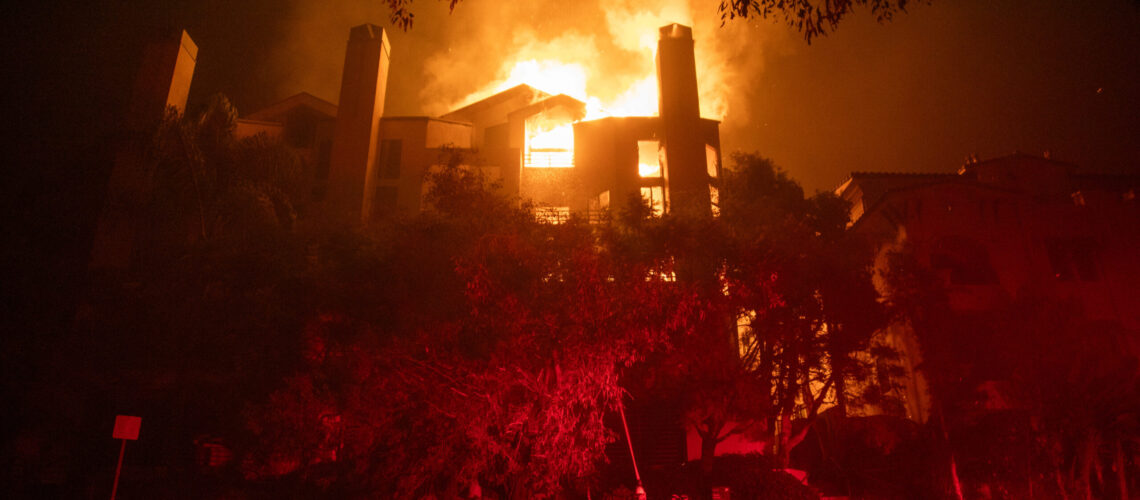California wildfires may require catastrophic insurance payout
January 10, 2025

- After the fire, the insurance battles: LA victims’ ordeal may just be beginning | California wildfires
- What to do if you lost your home, business in the fires; how to file insurance claim
- Palomar acquires First Indemnity of America Insurance Company
- AI has a growing role in processing health insurance claims
- Roadzen Secures $5M Through Share Offering to Fuel AI Insurance Technology Growth
On Thursday, wildfires continued to burn across Los Angeles County, bringing severe destruction. Many residents have lost their homes, and at least five people have died.
Bạn đang xem: California wildfires may require catastrophic insurance payout
Early estimates suggest that $50 billion in economic damage has already been done. Insured losses could amount to $20 billion, a huge sum for an insurance market that was under significant strain even before the catastrophic blazes started.
Benjamin Keys, a professor of real estate and finance at the University of Pennsylvania’s Wharton School, joined “Marketplace” host Amy Scott to talk about the California insurance market and what the payout might look like once claims come in. An edited transcript of their conversation is below.
Amy Scott: These fires are burning as California is in the midst of a homeowners insurance crisis. How would you describe the situation there?
Xem thêm : Asphalt shingle roofs in Florida may need to go
Benjamin Keys: Yeah, I think the crisis really comes from the household level. California’s insurance market has been very tightly regulated for a long time, and that’s made the market generally favorable for consumers, but climate change-induced disasters in recent years have really stressed that system. It’s led a number of large insurers to exit the state or circumscribe where they write policies, and it’s pushed a lot of homeowners into the state’s insurer of last resort, the FAIR plan.
Scott: Yeah, I read, I think, in The Financial Times today that the FAIR plan, as of the end of September, had almost $6 billion of exposure just in the Pacific Palisades area, where, you know, these fires are burning. How does California absorb these losses?
Keys: Well, historically, these types of FAIR plans were designed to be a Band-Aid on the insurance market, and in the last few years, they have expanded way beyond their initial intended use. The FAIR plan in California has grown from about $50 billion of exposure in 2018 up to over $450 billion of exposure as of this September, so a ninefold increase. And I think the question is going to be whether that system is able to handle a shock as large as this one. We’ll see what the final tally is in terms of damages. But this is a system where the commissioner of the system has been very clear about saying that the rates are not set in a competitive manner, and they also don’t have much of a capital cushion. And so that means that the rest of the state is likely on the hook if the losses are large enough, and you can think of that as an indirect tax on other California homeowners.
Scott: At the end of last year, California’s insurance commissioner, Ricardo Lara, put in some new policies to try to stabilize the market and expand coverage in areas prone to wildfires. Can you talk about some of those changes and whether you expect that to help in this situation?
Keys: Yeah, California has been very tightly regulated in a number of ways, and part of this goes back to a proposition that was passed in the 1980s. It’s been difficult for insurers to operate in the ways that they would like when it comes to setting their policy premiums, and also the types of information that they’re allowed to use when setting those premiums. And so California has been very restrictive in terms of, you know, relying only on backwards-looking data rather than on some of the sophisticated catastrophe models. And we’ve seen the climate evolving so rapidly, especially for disasters like wildfires, insurers have been desperate to use more information that they have at their fingertips when setting premiums. I think these reforms are likely to bring more insurers back to the table. This is largely what they were looking for, but a large disaster like this one is going to make them question whether it makes sense to write policies in some of these risky areas, and then ultimately, what’s the right price? What’s the right premium for policies that are exposed to wildfires?
Xem thêm : Why new homes could be affordable solution to insurance costs
Scott: As you and I have talked before, this is not just a California issue. You know, people around the country are seeing their premiums go up or getting nonrenewal notices as these disasters increase. Do you think we’re any closer to solving this problem?
Keys: Well, we haven’t really set out a list of policy solutions. We’re still at a very early stage when it comes to addressing these problems. I think we’re still in the diagnosis phase. And you’re looking at a very splintered regulatory landscape. Insurance is regulated at the state level. The federal government plays a relatively small role in insurance markets, and so I think we need a much more holistic approach that combines local, state and federal data and information from policymakers and from industry to wrap our hands around the problem. And then we need to think about broad-based measures to stabilize the market and make it much more affordable and accessible for the average homeowner.
There’s a lot happening in the world. Through it all, Marketplace is here for you.
You rely on Marketplace to break down the world’s events and tell you how it affects you in a fact-based, approachable way. We rely on your financial support to keep making that possible.
Your donation today powers the independent journalism that you rely on. For just $5/month, you can help sustain Marketplace so we can keep reporting on the things that matter to you.
Nguồn: https://propertytax.pics
Danh mục: News
